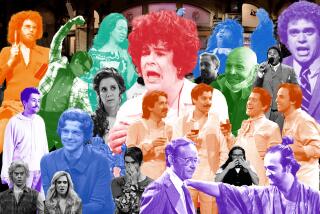Leaping ahead of the curve
DANCE in 2006 offered local audiences many exciting contemporary experiments -- some of the best of them exploring mixed-media with great surety. And near year’s end, Israeli choreographer Ohad Naharin’s millennial modern dance training system, Gaga, made his Batsheva Dance Company of Israel into heralds of a future that promises unprecedented levels of articulation and mutability.
The year also gave balletomanes new hope with the birth of Los Angeles Ballet, and provided innovative programming for the world dance public at UCLA’s Glorya Kaufman Dance Theater. Still, the city needs a dance center -- a black-box space dedicated to the art where emerging artists can rehearse and perform without going broke and audiences can discover and support the best of them.
What follows are 10 highlights from one aficionado’s datebook, in chronological order.
*
“Can You Hear Me: Asian Dance Voices,” Kaufman Dance Theater, UCLA, January. We all try to reconcile past values with present realities, and who better to teach us the way than passionate young dancer/choreographers from Cambodia, Malaysia and Indonesia: cultures engaged in that task for centuries.
*
Holy Body Tattoo in “monumental,” UCLA Live series, Royce Hall, April. Initially keeping their nine dancers atop box-like platforms, Canadian choreographers Noam Gagnon and Dana Gingras relied on lighting and music as much as movement invention to give their stark concept the impact of total theater. High risk -- and brilliant.
*
“Cambodian Stories,” the REDCAT and Cal State Long Beach, April. Interacting with 10 members of Cambodia’s Reyum Institute for Arts and Culture, Japanese dance artists Eiko and Koma shaped a haunting depiction of artists trying to survive catastrophic events without losing faith in themselves or their heritage.
*
Mikhail Baryshnikov and Hell’s Kitchen Dance, Lobero Theatre, Santa Barbara, June. The experimental, multimedia collaborations on this program featured recent and current New York dance students but peaked when the 58-year-old Baryshnikov danced magical duets with film images of himself shot at the dawn of his groundbreaking career.
*
Loretta Livingston’s “Blooming, Re-Joyce-ing,” Central Library, downtown, June. A searching examination of events and ideas in James Joyce’s “Ulysses,” this complex collaborative project grew most trenchant when giving a contemporary woman’s perspective on dated Joycean concepts of femininity.
*
Dance Camera West (the whole festival), various venues, June. For once this annual event dumped hyperkinetic films irrelevant to dance in favor of adventuresome and often thrilling collaborations between directors and choreographers.
*
Miami City Ballet in “Dances at a Gathering,” Pavilion, L.A. Music Center, July. “Don’t dance to the music. Let it take you,” Jerome Robbins said when creating this intuitive, spellbinding abstraction to Chopin piano pieces -- and the accomplished Miami dancers delivered exactly what he wanted.
*
Bill T. Jones’ “Another Evening: I Bow Down,” Bovard Auditorium, USC, October. Combining history, poetry, assaultive rock music and stream-of-consciousness contemporary choreography, this new, full-evening meditation on forces of nature confirmed Jones’ ability to make unusual themes into potent subjects for dance.
*
“Swan Lake,” the Kirov Ballet, Orange County Performing Arts Center, October. A sublime women’s corps and an insightful, often revelatory performance by Diana Vishneva closed the Mariinsky Festival with an indelible statement of Russian primacy in the 19th-century classics.
*
New Adventures in “Edward Scissorhands,” Ahmanson, L.A. Music Center, December. Matthew Bourne’s full-evening dance adaptation of Tim Burton’s 1990 feature film imaginatively combines humor and fantasy to show an innocent outsider dazzled and then brutalized by modern life. Still running.
*
The worst
At the end of a year in which the network reality series “Dancing With the Stars” and “So You Think You Can Dance” achieved news-making popularity, PBS announced a 2006-2007 season of “Great Performances” with no ballet or modern dance whatsoever -- just one Broadway dance musical. Repeated calls to PBS representatives yielded the hope that a Royal Ballet tape already shown in England might be acquired -- and that outtakes from the “Dance in America” miniseries “Free to Dance” could be edited into a new program titled “Dancing in
the Light” sometime in the late spring or early summer. But at press time, that’s all: There are no other tidings of comfort and joy from a network that within living memory has been a major force for education and audience renewal in the American dance world.
*
More to Read
The biggest entertainment stories
Get our big stories about Hollywood, film, television, music, arts, culture and more right in your inbox as soon as they publish.
You may occasionally receive promotional content from the Los Angeles Times.










